Crown rot tolerance levels in current and future cultivars
Crown rot tolerance levels in current and future cultivars
| Date: 26 Feb 2013
Rob Long (CAS, B&W Rural) and Drew Penberthy (CAS, Penagcon)
Take home messages
- EGA Bellaroi
 showed significant yield losses in the presence of crown rot at all 3 sites.
showed significant yield losses in the presence of crown rot at all 3 sites. - Yield performance for a number of potential new wheat varieties look promising relative to EGA Gregory
 in the presence of crown rot.
in the presence of crown rot. - Current ratings are a fair representation of crown rot (CR) index and % yield loss.
- The current rating system does not take into account a variety’s inherent yield capability, therefore there is variation between the ratings and actual yield under disease pressure.
- There is merit in establishing a crown rot tolerance rating system which does account for the yield potential of a variety when exposed to low, medium or high crown rot risk.
- This objective data was financially subsidised by GRDC and three seed companies, demonstrating their commitment to breeding for higher yields using improved crown rot tolerance.
Background
In 2007-2009 NGA ran a series of trials across the NW NSW to assess the impact of crown rot on winter cereal yields. 2007 had a very hot, dry finish and they showed some significant yield losses from the addition of crown rot inoculum. 2008 and 2009 were softer springs and crown rot had less impact on yield.
In 2011 and 2012 Crown Analytical Services, in collaboration with Australian Grain Technologies P/L, Longreach Plant Breeders and Heritage Seeds, replicated this trial methodology to screen selected current and future cultivars for yield performance in the presence of a known amount of crown rot inoculum.
The crown rot inoculum is added as sterilized durum seed which has been colonized with the fungus Fusarium pseudograminearum and applied at a rate of 2 g/m row.
14 new varieties plus 5 check varieties (EGA Gregory , EGA Wylie
, EGA Wylie , Sunco, EGA Bellaroi
, Sunco, EGA Bellaroi and Strzelecki
and Strzelecki ) were assessed. EGA Gregory
) were assessed. EGA Gregory was chosen as the “Standard” to which all others were compared, as a function of its current commercial popularity.
was chosen as the “Standard” to which all others were compared, as a function of its current commercial popularity.
2012 Sites
The aim is to plant these trials into commercial paddocks that by their rotation have low levels of background CR inoculum.
Previous crop rotations:
Weemelah (approx 180mm starting soil water)
- 2010 Sunbrook wheat
- 2011 PBA HatTrick
 chickpeas (cultivated & Kelly chained over summer)
chickpeas (cultivated & Kelly chained over summer) - 2012 wheat
Rowena (approx 200mm starting soil water)
- 2007 Sunvale wheat
- 2008 chickpeas
- 2009/10 double skip cotton (on long fallow)
- 2011 No winter crop established
- 2012 wheat
Bellata (217mm starting soil water)
- 2009 Gregory
 wheat
wheat - 2010/11 solid sorghum (on long fallow)
- 2011 PBA HatTrick
 chickpeas (double cropped)
chickpeas (double cropped) - 2012 wheat
Assessments
- Establishment.
- NDVI (biomass).assessed at GS30.
- Basal browning – incidence (%) & severity (0-5 rating), when combined (incidence x severity)/5 is a crown rot index of 0-100, assessed at GS90.
- Whiteheads, assessed at GS85 and GS90.
- Yield
- Quality (protein, test weight, screenings)
Results
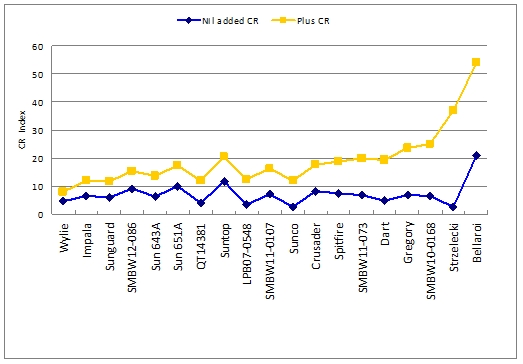
Figure 1: crown rot index by variety 2012 (3 sites combined)
- Crown rot index /100 is a measure of crown rot incidence and severity
- All varieties showed an increase in CR Index with added CR inoculum.
- Suntop had high incidence readings at one site.
- EGA Wylie was the least impacted by crown rot. EGA Bellaroi was the worst.
Tables 1& 2: Yield loss by crop x CR index at each site
|
Average bread wheat yields x CR index, 2012 |
||||||
|---|---|---|---|---|---|---|
|
Bellata |
Weemelah |
Rowena |
||||
|
CR Index |
Yield |
CR Index |
Yield |
CR Index |
Yield |
|
|
- CR |
2.8 |
3.75 |
4.0 |
3.37 |
9.0 |
3.40 |
|
+CR |
5.0 |
3.66 |
13.4 |
3.27 |
28.4 |
3.32 |
|
-2.6% |
|
-2.7% |
-2.5% |
|||
|
Average durum yields x CR index, 2012 |
||||||
|---|---|---|---|---|---|---|
|
Bellata |
Weemelah |
Rowena |
||||
|
CR Index |
Yield |
CR Index |
Yield |
CR Index |
Yield |
|
|
- CR |
20.7 |
3.50 |
20.4 |
3.03 |
16.9 |
2.68 |
|
+CR |
58.9 |
2.49 |
48.9 |
2.25 |
48.7 |
1.99 |
|
-28.9% |
|
-25.6% |
-25.7% |
|||
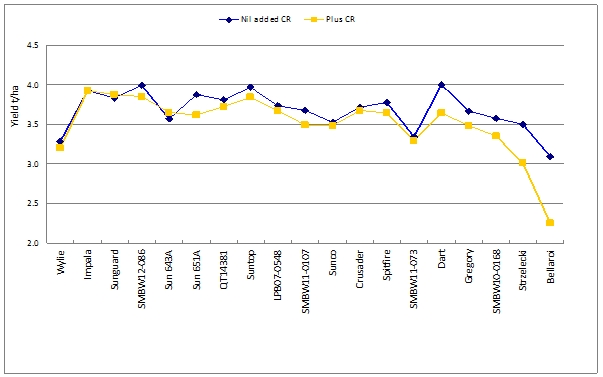
Figure 2: Actual yield by variety (3 sites combined)
- EGA Bellaroi
 durum performance was significantly affected by crown rot.
durum performance was significantly affected by crown rot. - Average bread wheat yield loss due to CR: 103 kg/ha (2.6%)
- Average EGA Bellaroi
 durum yield loss due to CR: 830 kg/ha (26.7%)
durum yield loss due to CR: 830 kg/ha (26.7%) - EGA Wylie
 was the second lowest yielding bread wheat despite not losing yield to CR.
was the second lowest yielding bread wheat despite not losing yield to CR.

Figure 3: Yield loss x variety, 2012 (3 sites combined)
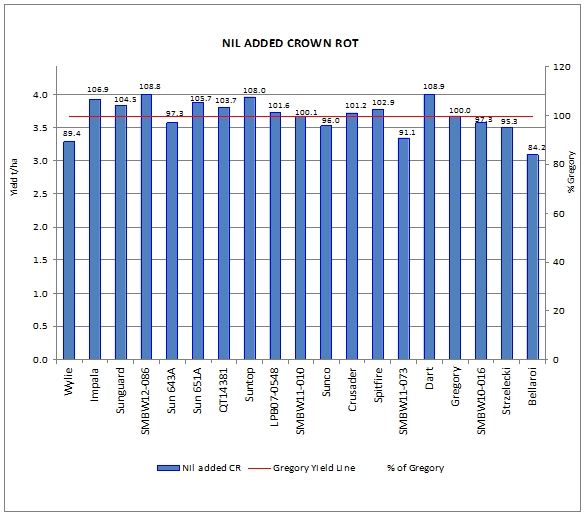
Figure 4: Yield (t/ha) by variety compared to EGA Gregory with nil added CR - 3 sites.
with nil added CR - 3 sites.
- EGA Gregory
 is shown as the standard due to its current commercial popularity.
is shown as the standard due to its current commercial popularity. - Strong EGA Gregory
 yield under lower crown rot pressure.
yield under lower crown rot pressure.

Figure 5: Yield (t/ha) by variety compared to EGA Gregory with plus CR - 3 sites.
with plus CR - 3 sites.
- EGA Gregory
 is shown as the standard due to its current commercial popularity.
is shown as the standard due to its current commercial popularity. - Positive yield trends for most of the new suite of varieties relative to EGA Gregory
 in the higher presence of crown rot. In other words, the more CR tolerant varieties outperformed EGA Gregory
in the higher presence of crown rot. In other words, the more CR tolerant varieties outperformed EGA Gregory when exposed to higher inoculum levels.
when exposed to higher inoculum levels.
Quality
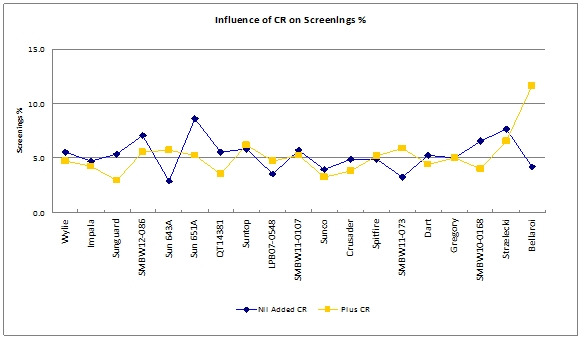
Figure 6: Influence of CR on screenings % – 3 sites.
- Screenings doubled in EGA Bellaroi
 durum due to added CR
durum due to added CR - Inconsistent trends in bread wheat
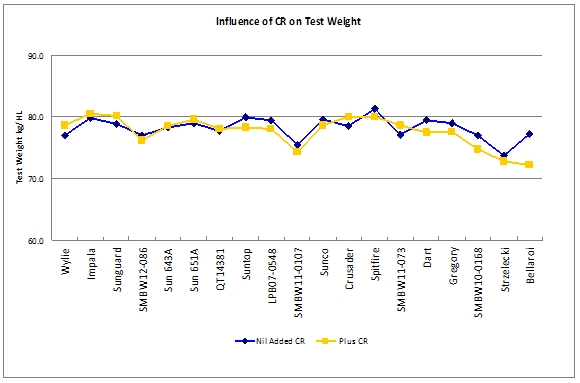
Figure 7: Influence of CR on Test Weight (kg/HL) – 3 sites
- No issue apart from EGA Bellaroi
 durum
durum
How well do the current ratings stack up?
Table 3: Current crown rot Resistance Ratings v CAS 2012 Yields.
|
Variety |
NSW Rating |
Qld Rating |
CAS - PLUS CR Yield 2012 |
|---|---|---|---|
|
EGA Wylie |
MR- MS |
MR-MS |
91.9 |
|
Sunguard |
MR-MS(p) |
MS |
111.2 |
|
Suntop |
MR- MS |
- |
110.3 |
|
Sunco |
MS |
MS |
99.9 |
|
LongReach Crusader |
MS |
S |
105.5 |
|
LongReach Spitfire |
MS |
MS |
104.4 |
|
LongReach Dart |
MS – S |
- |
104.4 |
|
LongReach Impala |
MS - S |
MS |
112.5 |
|
EGA Gregory |
S |
S |
100.0 |
|
Strzelecki |
S |
S |
86.3 |
|
EGA Bellaroi |
VS |
VS |
64.6 |
- Current ratings are a fair representation of crown rot index and % yield loss.
- The current rating system does not take into account a variety’s inherent yield capability, therefore there is variation between the ratings and actual yield under disease pressure.
- There is merit in establishing a crown rot tolerance rating system which accounts for the yield potential of a variety when exposed to low, medium or high crown rot risk.
- More work will be required to define what constitutes low, medium & high crown rot risk. It will be a combination of inoculum load, plant available water content at sowing and a combination of soil physical and chemical parameters that influence the crops water extraction capability during grain fill.
Acknowledgements
- Richard Daniel (NGA)
- Steve Simpfendorfer, Denis Harvey and the Kalyx team, Susan Fletcher and Alison Kelly (Qld DAFF)
- Steve Jefferies & Kerrie Gleeson (Aust Grain Technologies), Adrian McNair, Lindsay O’Brien (Longreach) and Ben Adams (Pac Seeds), Todd Jones and Col Smith (Heritage Seeds)
- Farmer co-operators John Madden, Jason & Lisa Orchin, Drew Penberthy.
Contact details
Rob Long
CAS, B&W Rural
Ph: 0428 971 751
Email: robert.long@elders.com.au
 Varieties displaying this symbol beside them are protected under the Plant Breeders Rights Act 1994.
Varieties displaying this symbol beside them are protected under the Plant Breeders Rights Act 1994.
GRDC Project Code: CRA001: Cultivar crown rot tolerance trials,
